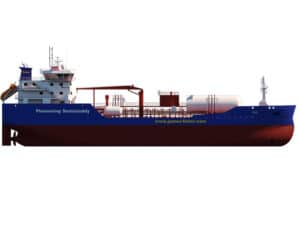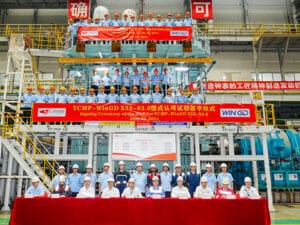
Op-Ed: Bio-LNG production is scaling rapidly
Written by Heather Ervin
Steve Esau, Chief Operating Officer, SEA-LNG
By Steve Esau, Chief Operating Officer, SEA-LNG
The European Commission’s REPowerEU plan aims to boost European biomethane production tenfold from 3.5 bcm today to 35 bcm per year by 2030. Much of this biomethane will be available to shipping in the form of bio-LNG and can be used in existing LNG-fuelled vessels without any modification, as well as transported, stored and bunkered in ports using established infrastructure.
Bio-LNG production
Bio-LNG, as its name suggests, is simply biomethane that has been liquefied by cooling it to minus 161 degrees Celsius. Currently the main way to produce biomethane is through anaerobic digestion of waste biomass such as manure. The waste biomass is put into a digester where it produces something called biogas. Impurities are then removed from this biogas, resulting in streams of pure biomethane and biogenic CO2. Biomethane is then used directly as a fuel or liquefied into bio-LNG. The CO2 can be used, for example, in greenhouses to promote crop growth or as a feedstock for synthetic fuels, such as e-methane.
Methane is emitted naturally from agricultural waste if it is spread on land as a fertilizer, or otherwise left to break down. If this is taken into account, the avoided emissions achieved in certain bio-LNG production also supports waste management and the circular economy by assisting in the reprocessing of waste.
For bio-LNG to be truly carbon neutral, or even carbon negative, it must be produced from sustainable biomass feedstocks. Sustainable biomass feedstocks are those that do not compete with food, fibre or fodder production such as waste streams, residuals from agricultural or forestry residues, and dedicated energy crops grown on marginal land unsuitable for crop production.
Bio-LNG is already being used in the shipping industry and there are several examples of it being bunkered today. Looking at SEA-LNG’s membership alone—Gasum, Shell, TotalEnergies and Titan are already supplying bio-LNG to major shipowners.
There are bio-LNG production (or biomethane liquification) plants popping up left, right and centre as more shipowners and operators recognise the benefits of bio-LNG and the LNG pathway to decarbonization more broadly. Titan, for example, has announced it will build the world’s largest biomethane liquefaction plant in the Port of Amsterdam. Bio-LNG production is expected to commence in 2025 with the plant ultimately producing up to 200,000 tonnes of bio-LNG per year.
In addition, Gasum is creating five large new biogas plants in southern Sweden. The construction of the first will begin during 2023 and the plants will use 1.8 million tons (750 GWh) of different kinds of waste streams for feedstock to produce 55,000 tonnes of bio-LNG per year.
Bio-LNG cost and availability
The latest independent study—commissioned by SEA-LNG and conducted by the Maritime Energy and Sustainable Development Centre of Excellence (MESD CoE) at Nanyang Technological University Singapore (NTU Singapore) – explored questions around bio-LNG availability, cost, lifecycle emissions and logistics.
The report shows that bio-LNG is the lowest cost sustainable and scalable alternative marine fuel, compared, for example with to bio-methanol and electro-fuels, including e-ammonia and e-methanol. It forecasts that the average cost for delivered bio-LNG will fall by 30% by 2050 compared to today’s values, mainly driven by the reduced cost of producing biomethane in large-scale anaerobic digestion plants.
The research findings also show that bio-LNG could cover up to 3% of the total energy demand for shipping fuels in 2030 increasing to 13% in 2050. even when taking into account growing demand for biomethane from other sectors of the economy. If used as a drop-in fuel blended with fossil LNG, bio-LNG could cover up to 16% of the total energy demand in 2030 and 63% in 2050, assuming a 20% blending ratio.
The bottom line is that the LNG pathway currently offers the lowest cost, lowest risk and most practical pathway to zero-emission shipping. Bio-LNG, and then renewable synthetic e-LNG, can be incrementally introduced into the fuel mix to reduce emissions as production scales. Waiting as GHG emissions accumulate is not an option; with LNG, shipowners can begin the decarbonization process right now.




